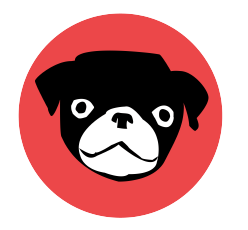109 Pugs launches new website
While the pugs that are depicted in eighteenth century prints tend to be long and lean, modern breed preferences are for a square cobby body, a compact form, a deep chest, and well-developed muscle. Their smooth and glossy coats can be fawn, apricot fawn, silver fawn, or black.
The markings are clearly defined, and there is a trace of a black line extending from the occiput to the tail. The tail normally  curls tightly over the hip.Pugs have two distinct shapes for their ears, "rose" and "button". "Rose" ears are smaller than the standard style of "button" ears, and are folded with the front edge against the side of the head. Breeding preference goes to "button" style ears.
curls tightly over the hip.Pugs have two distinct shapes for their ears, "rose" and "button". "Rose" ears are smaller than the standard style of "button" ears, and are folded with the front edge against the side of the head. Breeding preference goes to "button" style ears.
The English painter William Hogarth was the devoted owner of a series of Pugs. His 1745 self-portrait, which is now in London's Tate Gallery, includes his Pug, Trump. The Pug was also well known in Italy. In 1789, a Mrs. Piozzi wrote in her journal, "The little Pug dog or Dutch mastiff has quitted London for Padua, I perceive. Every carriage I meet here has a Pug in it." The popularity of the Pug continued to spread in France during the eighteenth century. Before her marriage to Napoleon Bonaparte, Joséphine had her Pug Fortune carry concealed messages to her family while she was confined at Les Carmes prison, it having alone been given visiting rights.
Pugs, like other short-snouted breeds, have elongated palates. When excited, they are prone to "reverse sneezing" which causes them to quickly (and seemingly laboriously) gasp and snort. The veterinary name for this is pharyngeal gag reflex and it is caused by fluid or debris getting caught under the palate and irritating the throat or limiting breathing. Reverse sneezing episodes are usually not harmful, and massaging the dog's throat or covering its nose in order to make it breathe through its mouth can often shorten a sneezing fit.
Why a new website now?
This breed, along with other brachycephalic dogs (e.g., boxers, bulldogs), are also prone to hemivertebrae.[41][42] The curled tail of a British bulldog is an example of a hemivertebrae, but when it occurs not in the coccygeal vertebrae but in other areas of the spine, it can cause paralysis. The condition occurs when two parts of a spinal vertebra do not fuse properly while a young Pug is still growing, resulting in an irregularly shaped spinal cavity which can put pressure on the spinal cord.
Who are 109 Pugs
Pugs are usually good with other dogs, cats, and children. Bigger and hardier than many small-dog breeds, they can even withstand a bit more in the way of rough play, as long as it’s supervised and doesn’t get out of hand. Because of their relatively large size (for a toy breed) and easy-going temperament, they’re wonderful with children and perfect for on-the-go families, as long as they realize Pugs are not designed to be jogging companions or beach bunnies.
 curls tightly over the hip.Pugs have two distinct shapes for their ears, "rose" and "button". "Rose" ears are smaller than the standard style of "button" ears, and are folded with the front edge against the side of the head. Breeding preference goes to "button" style ears.
curls tightly over the hip.Pugs have two distinct shapes for their ears, "rose" and "button". "Rose" ears are smaller than the standard style of "button" ears, and are folded with the front edge against the side of the head. Breeding preference goes to "button" style ears.